| |
The Jig Is Up
by Mark Martin
If you want to improve or expand your jigging capabilities, try
these tricks from maestro Mark Martin.
Jigging, I'm afraid, is one of the least understood methods for
catching walleyes. Certainly it's the topic I'm asked about most at seminars
and at the launch ramp. In spring and early summer, though, it's
perhaps the most effective technique for catching walleyes in rivers
and lakes anywhere in the walleye belt. That's why it's time for a
refresher course in vertical jigging and for a quick course in
Walleye Fishing 201 (that is, fishing with soft plastics). Whether
you're trying to refine technique or to take it to a new level, stay
in the vertical plane and experiment with plastics to go places
you've never gone before.
walleyes. Certainly it's the topic I'm asked about most at seminars
and at the launch ramp. In spring and early summer, though, it's
perhaps the most effective technique for catching walleyes in rivers
and lakes anywhere in the walleye belt. That's why it's time for a
refresher course in vertical jigging and for a quick course in
Walleye Fishing 201 (that is, fishing with soft plastics). Whether
you're trying to refine technique or to take it to a new level, stay
in the vertical plane and experiment with plastics to go places
you've never gone before.
I want to learn how to vertical jig better on rivers? Help!
Don't worry, you will get better. That happens when you pay
attention to details of tackle, jigs and boat control. Altogether,
the three ingredients unite with a recipe for success.
For starters, you want a short rod for vertical jigging, nothing
longer than a six-footer. The reason is that a short rod gives you
control over the jig and helps keep the jigging motion to a minimum.
(Go longer, say a 6-foot, 6-inch or 7-foot rod, and you're going to
lift and drop the jig with way too much oomph.) The most common
mistake I see from other river anglers is jigging the jig far too
much. I try to keep my jigging motion less than six inches, better
yet if the jig is dead still or moving less than two to three inches
from bottom. That's far easier with a six-foot Berkley Series One
spinning rod, which is light and sensitive to help detect light
strikes. It's also easier if you concentrate, a key component to
vertical jigging. Concentrate hard enough instead of jawing with
your buddy, and you will no longer snap a jig a foot off the bottom
you'll keep it close to bottom and in the zone. Berkley FireLine
also is going to help you maintain contact with the jig. There's no
stretch in FireLine, which provides excellent sensitivity. But be
sure to use light FireLine; and try it, too, Flame (bright yellow).
Don't go over 8-pound FireLine, which has the same diameter as
3-pound monofilament. My favorite is 6-pound. The thin diameter
helps cut current and improve your connection with the jig. The
Flame line, meanwhile, lets you easily see the angle of the jig and
direction of the line.
For the jigs themselves, start with the heaviest, not the
lightest, jig you can get away with. That idea runs counter to
prevailing wisdom, but when you're learning, you don't want to go
too light. Otherwise, you're line will go off at an angle and you'll
no longer be fishing vertically, the whole idea in the first place.
With a heavy jig, maybe as big as 1/2- to 3/4-ounce, you're going to
stay vertical. Pick up a selection of Northland FireBalls in a
variety of sizes, including the monstrous ones if you're fishing
serious current. They're just what you need for fishing a jig and
minnow on the river. Often, I soften the package with a piece of
Berkley PowerBait, which also provides bulk and visibility in the
dark water common to rivers.
Now comes the final ingredient your boat control. Vertical means
vertical. When you're on the bowmount trolling motor in a river, you
want to chase your line to keep it vertical. That means when your
line starts getting off on an angle and away from vertical, you want
to give the motor a burst in that direction to return the line to
vertical. With a burst of power, you can now chase after the line
with the boat. Of course the current is going to be moving
downriver, but the wind is another factor to consider. Whichever way
it's blowing, put the bow of the boat into the wind to let you
control the boat and push it in whatever direction is necessary to
keep the jig vertical.
What about a bite? Well, it goes back to the concentration.
Sometimes river walleyes will pop a bait, and you'll feel the
"tick." Other times they'll just hang on and you'll feel the
slightest weight. Or they'll even rise up with it and your line will
go slack. Whichever it is, set the hook. Beyond all that, don't
forget to practice vertical jigging just another great excuse to go
fishing.
Do soft plastics really work for catching walleyes on jigs? I'm
doubtful. Walleyes love bait, don't they? You bet walleyes love live
bait. They also love plastics under the right conditions, which I'm
finding is more often than not.
One situation is in rivers, where walleyes scoop up whatever
seems edible that is drifting down their way. A favorite offering I
learned about on the Detroit River is strange but true. On a
long-shank jighead, I thread a Berkley Power Minnow up the hook.
Then I tip the jig with an inch or two of plastic work, such as a
Power Crawler, as if it were live bait. You jig it as you would
bait, working it vertically, keeping it within a few inches of
bottom. But in current, the twin tails flap every which way. I also
like the way the tails provide size and bulk, it's like fishing a
crankbait-sized profile, only much slower. The rig also excels on
lakes when the wind is ripping and boat control is difficult.
Over the last few years, I've started snap-jigging plastic worms
and Power Minnows where I might otherwise have fished bait. One
excellent worm is a four-inch Power Worm in pumpkin and chartreuse.
It's pretty much a bass bait, but it really catches walleyes.
Another favorite is a three-inch Power Minnow. If I'd normally fish
a spot with bait and a 1/8th-ounce jighead, I'd probably use a
1/4-ounce with plastic.
Here's how I do it: I cast out, let the jig sink to bottom and
tighten up the line. Then I snap the jig from 9 o'clock to 11
o'clock and let fall on a semi-slack line. (Again, FireLine helps
for sensitivity.) When it hits bottom, repeat. Work the jig all the
way back to the boat, and when it's under the boat, jig it a few
more times to attract a walleye that might have been following.
The most important lesson I can give is to make sure the jig hits
bottom after every time you snap it. Too many people will have the
jig reach the boat six inches under the surface. That's nowhere near
bottom. You have to have the patience and timing to let the jig hit
bottom between aggressive snaps. When you do, you'll either feel the
walleye inhale the jig on the drop or set the hook when you go to
snap it again.
Plastic is not an easy aversion to overcome. It's far easier to
depend on crawlers, leeches and minnows on a jig. And there's
nothing wrong with that. Plastics, however, are a great way to
search more quickly for fish and to trigger neutral walleyes that
aren't quite in the mood. When plastic bursts past them, that's
often the trick to get them to go. Try it. I guarantee you'll like
it. |




 walleyes. Certainly it's the topic I'm asked about most at seminars
and at the launch ramp. In spring and early summer, though, it's
perhaps the most effective technique for catching walleyes in rivers
and lakes anywhere in the walleye belt. That's why it's time for a
refresher course in vertical jigging and for a quick course in
Walleye Fishing 201 (that is, fishing with soft plastics). Whether
you're trying to refine technique or to take it to a new level, stay
in the vertical plane and experiment with plastics to go places
you've never gone before.
walleyes. Certainly it's the topic I'm asked about most at seminars
and at the launch ramp. In spring and early summer, though, it's
perhaps the most effective technique for catching walleyes in rivers
and lakes anywhere in the walleye belt. That's why it's time for a
refresher course in vertical jigging and for a quick course in
Walleye Fishing 201 (that is, fishing with soft plastics). Whether
you're trying to refine technique or to take it to a new level, stay
in the vertical plane and experiment with plastics to go places
you've never gone before.